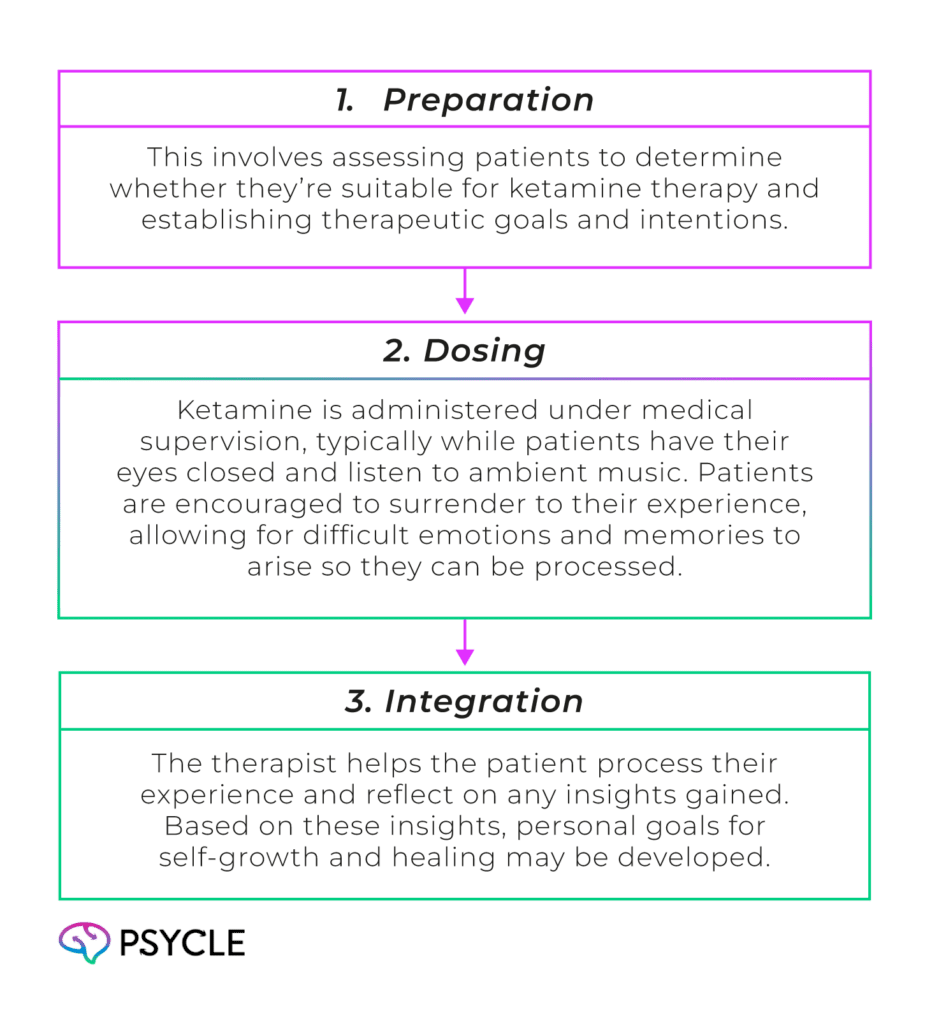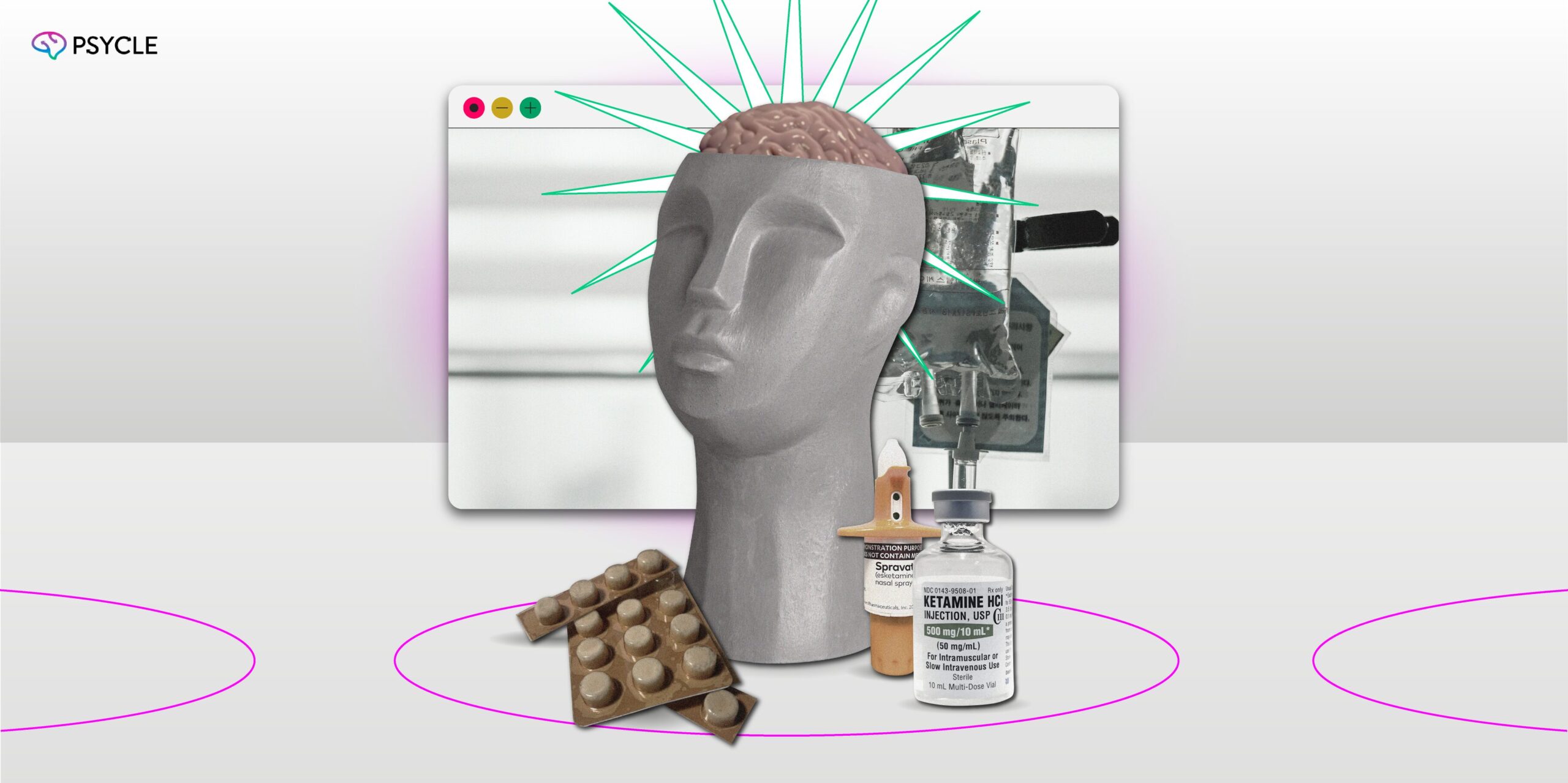Ketamine is a powerful therapeutic agent with unique psychedelic properties. This blog will discuss the mechanisms underlying ketamine’s psychedelic effects and how these contribute to its role in mental health treatment.
Key Takeaways
- Ketamine’s psychedelic effects, ranging from mild alterations in perception to profound dissociation, offer therapeutic potential in mental health treatment.
- Ketamine-assisted therapy and transpersonal healing harness these effects to facilitate introspection, emotional release, and spiritual insights.
- While ketamine’s psychedelic properties can be therapeutic in controlled settings, they necessitate careful supervision to mitigate risks of disorientation and vulnerability.
- Ongoing research and ethical considerations are vital as ketamine emerges as a promising tool in psychedelic-assisted therapy and holistic well-being.
Ketamine’s Historical Context and Current Research
In 1956, researchers at the Parke Davis Company developed phencyclidine (PCP) as a human anesthetic. Though the drug appeared to be physically safe, users often reported experiencing delirium, marked by hallucinations and detachment from reality.
Ketamine was later developed as a shorter-acting and less psychoactive version of PCP by the organic chemist Cavin Stevens. It became available in human anesthesia in 1969 under the name Ketalar and was widely used in emergency surgery during the Vietnam War.
In the late 1970s, two books describing psychedelic experiences on ketamine were published. This included Journeys into the Bright World by Marcia Moore and The Scientist by John Lily. With growing recognition for the drug’s psychedelic effects and concern about its recreational use, ketamine was placed among the Class Three category in the US Controlled Substances Act in 1999.
In the year 2000, Berman et al. conducted the first human clinical study to show the antidepressant effects of ketamine in patients. Numerous other studies have since found ketamine has fast-acting mental health benefits, particularly in depression. The FDA approved Spravato, a ketamine derivative, for treatment-resistant depression in 2019.
Moreover, with increasing recognition of the value of psychedelic experiences to assist therapy, the drug is becoming increasingly used off-label in therapeutic settings to treat mental health disorders.
Different Doses of Ketamine and Their Effects
At lower doses, ketamine typically induces mild alterations in mood and perception, including mild euphoria and dissociation. Lower doses of around 0.5-1mg/kg are used for procedural sedation (mild surgical procedures), and doses of between 0.1-1mg/kg in depression treatment.
At higher doses, ketamine can induce more profound dissociative and hallucinogenic effects, leading to an altered state of consciousness. At doses of over 150mg, people may go into a “K-hole,” which is characterized by detachment from reality, out-of-body experiences, and an altered perception of time and space.
When used in psychedelic therapy, clinicians may administer intravenous ketamine doses of between 0.5-2 mg/kg to induce these more psychoactive states.
The Pharmacology of Ketamine
Ketamine’s primary mechanism of action is blocking NMDA receptors, which are protein channels activated by glutamate. Glutamate is responsible for general electrical signaling in the brain, so blocking NMDA receptors can shut down certain brain pathways. By blocking inhibitory NMDA pathways, ketamine also activates other brain pathways. These changes in brain activity can lead to an altered state of consciousness.
Imaging studies show show ketamine disrupts activity in the default mode network (DMN), similar to other classical psychedelics such as LSD and psilocybin. The DMN is a network of brain regions thought to be responsible for one’s sense of self. Interrupting this network could explain why people experience dissociation and disconnection from self on high doses of ketamine.
Studies also show ketamine increases connectivity between brain regions that are normally less connected. This effect may underlie an “expanded consciousness” and altered perspectives that occur during ketamine-induced states.
Beyond NMDA, ketamine interacts with sigma receptors, which are proteins that modulate the release of other neurotransmitters. These receptors are thought to be involved in ketamine’s antidepressant effects and may also contribute to ketamine’s psychedelic effects since sigma-1 is also a primary target for the classical psychedelic DMT.
Ketamine and Mental Health
Ketamine-Assisted Psychotherapy and Integration
In clinical use for depression, multiple low doses of ketamine are provided over two to three weeks. Ketamine’s effect on glutamate and repair mechanisms in the brain are thought to address the biological damage associated with depression. No supporting therapy is given, but medical professionals will monitor patients to ensure their safety.
In ketamine-assisted therapy, higher doses of ketamine induce altered states of consciousness that can facilitate psychotheraputic exploration and insight. Ketamine-assisted therapy (KAT) aims to address underlying psychological issues of mental health disorders while promoting holistic well-being and personal transformation. KAT involves multiple psychotheraputic sessions divided into three stages.

The Role of Ketamine in Transpersonal Healing
Transpersonal healing is a holistic approach to mental health that extends beyond psychology alone. It focuses on the interconnectedness of mind, body, and spirit and aims to aid emotional stability while cultivating wholeness between the psychological and spiritual self. Transpersonal healing also aims to help individuals achieve self-actualization, fulfilling one’s life purpose.
Ketamine can assist transpersonal healing because it can induce mystical and transcendent states. These experiences often involve a temporary dissolution of the ego, which helps individuals break free from deeply ingrained patterns of thought and behavior and gain new perspectives on their lives. This state also allows for the processing and release of deep-seated emotions, enabling individuals to confront and integrate past traumas and unresolved issues in a supportive environment.
Users may also experience spiritual insights or a sense of unity with the universe, providing a sense of purpose and direction that is integral to the healing process.
Therapists are crucial in guiding individuals through these experiences, helping them set intentions before the session and integrating insights afterward. This therapeutic framework ensures that individuals can safely navigate the altered state, maximizing the potential for profound healing and transformation.
Therapeutic Applications of Ketamine
Clinical research has highlighted the benefits of ketamine and KAT in several mental health disorders, including:
- Depression
- Anxiety
- Substance abuse disorders
- Post-traumatic stress disorder (PTSD)
- Obsessive-compulsive disorder (OCD)
- Eating disorders
Potential Risks and Side Effects of Ketamine Use
Physical side effects of ketamine can include:
- Increased blood pressure and heart rate
- Nausea and vomiting
- Dizziness
- Headache
- Blurred vision
- Loss of appetite
- Muscle stiffness or spasms
Moreover, ketamine has an addictive potential, and chronic use has several health risks, including permanent urinary tract problems, liver and kidney damage, and cognitive impairments.
The psychedelic effects of ketamine, while sometimes therapeutic, can also be considered side effects depending on the context and the individual’s reaction. The altered sense of time and space can be disorientating and unpleasant for some.
Outside of therapeutic settings, these effects can be hazardous. An individual’s awareness and responsiveness to their environment are impaired, increasing the risk of accidents and injuries. This is why ketamine patients are cautioned not to drive or perform any mentally demanding physical tasks in the hours following their therapy.
Ethical Considerations and Future Directions
Ketamine-assisted therapy presents numerous ethical considerations, particularly because of its powerful effects on consciousness and psychological state. Patients must be fully informed about the potential effects and risks, and their consent should be obtained transparently and comprehensively.
The psychoactive effects of ketamine render patients vulnerable to financial and physical abuse during therapy, and there have been several instances of abuse in psychedelic-assisted therapy settings. Patients should seek certified and well-vetted professionals to administer ketamine to help avoid this risk.
Future directions involve ongoing research, standardization, and education. Clinical trials and practitioner training programs are essential for understanding and optimizing ketamine therapy. Policymakers must enforce guidelines to ensure patient safety while promoting therapeutic accessibility.
FAQs
How Do Ketamine’s Psychedelic Effects Manifest During Therapy Sessions?
Ketamine induces altered states of consciousness, characterized by perceptual distortions, ego dissolution, and spiritual insights, enhancing therapeutic exploration and transformation.
Are There Risks Associated With Ketamine’s Psychedelic Effects?
While ketamine’s psychedelic effects can be therapeutic, they may also cause disorientation and vulnerability, necessitating careful supervision during therapy sessions to ensure safety and well-being.
What are the Benefits of Ketamine-Assisted Therapy in Mental Health Treatment?
Ketamine-assisted therapy facilitates emotional release, introspection, and spiritual insights, offering a holistic approach to mental health that addresses psychological, emotional, and spiritual well-being.
How Can Individuals Ensure Safe and Effective Ketamine Therapy?
Seeking treatment from certified professionals in reputable clinics is essential to mitigate risks and maximize the therapeutic benefits of ketamine’s psychedelic effects in a supportive and controlled environment.

